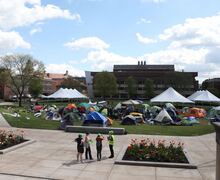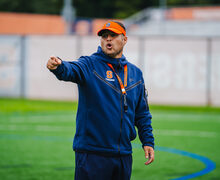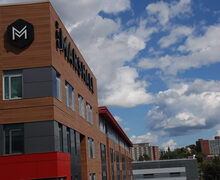Spring Break in Silicon Valley program reaches 5th year, allows students to network with alumni
Courtesy of Julie Walas-Huynh
Students participating in the Spring Break in Silicon Valley program visited high-tech corporations and startups in California. The program celebrates its fifth year this year.
Spring Break in Silicon Valley aims to bridge Syracuse and the West Coast.
During the yearly five-day program, students visit between 20–25 companies in Silicon Valley, California — an area known as the home to many high-tech companies and startups.
Spring Break in Silicon Valley program entered its fifth year in 2015 and took place this year on March 9–13. Students participating were able to visit corporations such as Twitter and Gobot. Shay Colson, director of West Coast relationships at the School of Information Studies and a Syracuse University alumnus, started the program in 2010.
“This bridge is built on the backs of Syracuse alumni,” Colson said. “We’re going into places where you can’t get an appointment, but because there’s a ‘Cuse alumnus, they open the door for students to come in.”
The program has evolved over the past five years, Colson said. One of the more notable changes has been the evolution of companies that want Syracuse students to visit them.
Colson added that the program brings around 15 students each year from any major across campus and has had every type of student from freshmen to Ph.D. students. Students from different majors and backgrounds bring new types of diversity to the program each year, he said.
“Every year is different, and every year we get to visit different companies — it’s a program that people get excited about,” said Erin Miller, a junior advertising major. “I’ve wanted to go on this since I was a freshman.”
The trip offers something different for each student. Miller said she most wanted to get a feel for the culture of the Silicon Valley.
“One of the biggest takeaways for trying to figure out where you want to be is a culmination of the team you’re going to work with and the product you’re working on. So it’s important to find a balance between company culture and worldly impact,” Miller said.
The group had the opportunity to network with both Syracuse alumni and start-up employees to get a feel for each company they visited, allowing them to understand what makes for a successful start-up. The program has visited an array of start-ups, ranging from a company operating out of the living room of a rented house to Twitter’s headquarters, Colson said.
“We had to beg, borrow and steal in the first year of the program, but we have had students that participated in this program in the last four years that are now working in Silicon Valley and are hosting us,” Colson said. “Now they’re reaching back saying, ‘Hey, I’ve been where you are,’ and, ‘Come visit me.’”
This year, a former Syracuse employee who used to accompany the students on the program hosted this year’s group in the Silicon Valley.
“Last year he was on the bus, and now he’s here with his own company hosting us,” Colson said. “This program creates amazing opportunities that students get to see firsthand and in person.”
Max Doblin, a senior advertising and entrepreneurship and emerging enterprises dual major, said he was most excited about networking with professionals who are also passionate about startups.
But Doblin also noticed what he calls the “disconnect between Syracuse University and Silicon Valley.”
“When Stanford (University) students get recruited, it’s from Google, Facebook and Twitter — while we’re isolated in the arctic tundra of Syracuse,” Doblin said.
Colson hopes the program’s ability to bring students who are passionate about start-ups to California will inspire Syracuse students to follow through with their own startup ventures.
“This trip gives them the follow-through they need to start companies, get great jobs and continue to host us again in the future.”
Published on March 16, 2015 at 12:01 am
Contact Kait: [email protected]




